One of the things that I really wanted to do while I was in Chengdu was to go to a panda conservatory and see the pandas. The first time I was in Chengdu for just 16 hours (several years ago), we had time to go to a mall and see the giant fake panda climbing onto the roof of the mall, but we hadn’t had time to go see the real pandas which is one of the big things to do in Chengdu.
When I told Jaye about this plan, she said that the place I’d heard about was the best one, but also had tons and tons of people. After a little research, she found another good place to see the pandas that was a little further away from the city but near 都江堰 (Dujiangyan, another place I wanted to see) and a mountain.
According to some things that she had read, Jaye found that we needed to go see the pandas early because later in the day when the weather was too hot, the pandas wouldn’t want to move and would just be sleeping. So Jaye booked tickets on a train that went outside the city to the panda area, and we woke up before 6 so that we could get to the train station on time. We joined the crowd of people and even though our train left at 7:36 a.m., the outdoor platform was already quite hot.
Most people seemed to be going to the mountain, but we booked a taxi that took us to the panda conservatory, and there weren’t too many people! Although we planned to go to the mountain next, the taxi driver told us that with this many people, the traffic would be terrible if we waited until 10 a.m. to try to go there. We realized that we might need to cut the mountain out of our plan.
We arrived at the panda park and headed toward the panda enclosures. The first one was empty, and I worried that we were already too late. But we kept walking, and soon we got to watch a panda eating his breakfast of bamboo. I was impressed that he could bite through the wood so easily, and it was fun to watch the pandas munch on the bamboo as they sprawled out on the ground. They seemed to be thoroughly enjoying themselves.
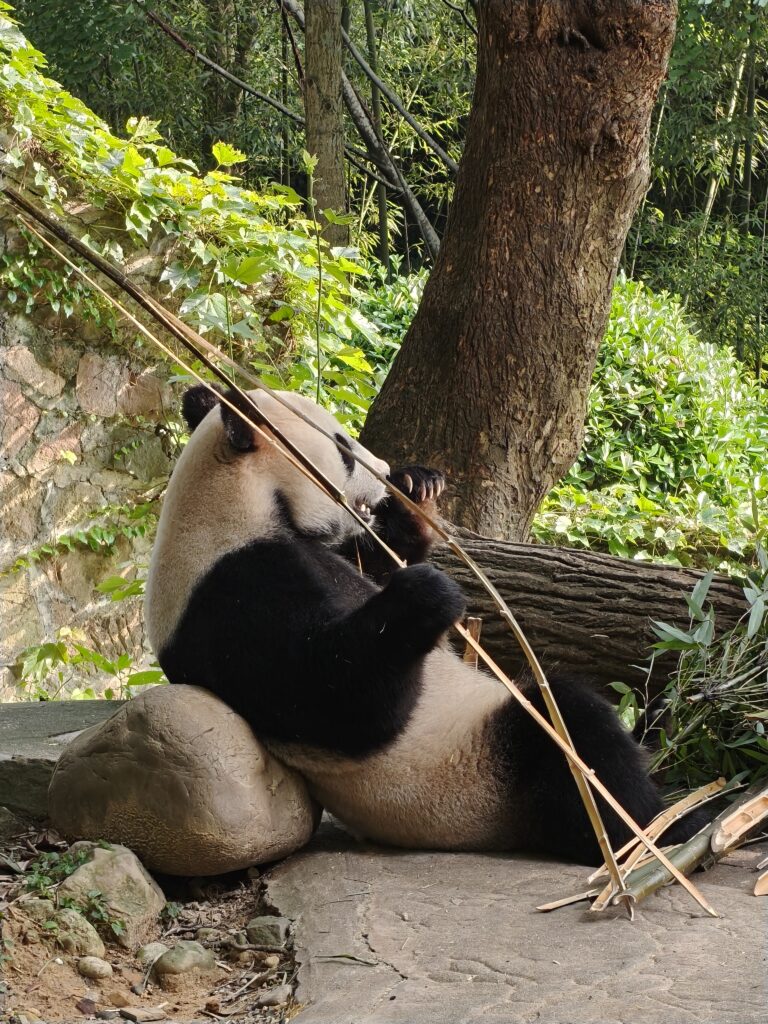
We kept walking and saw some adorable red pandas (in Chinese they are called “small pandas” 小熊猫), and we watched them for a while, but I wanted to spend most of the time looking at the big pandas since that was the main attraction. So we kept moving.
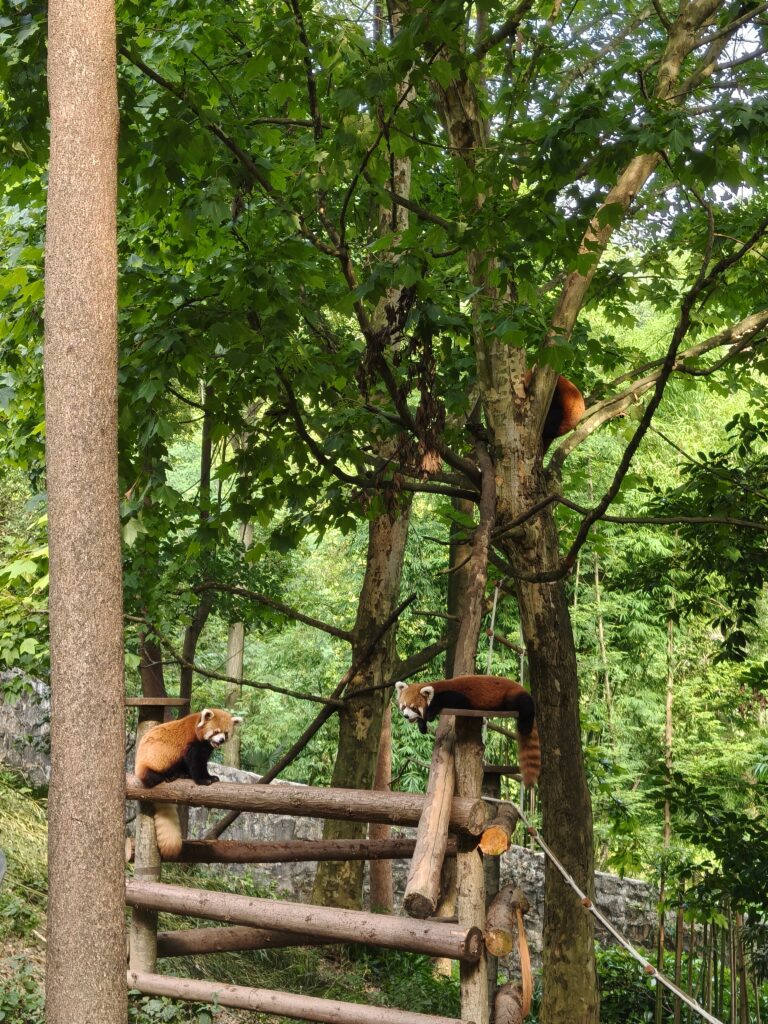
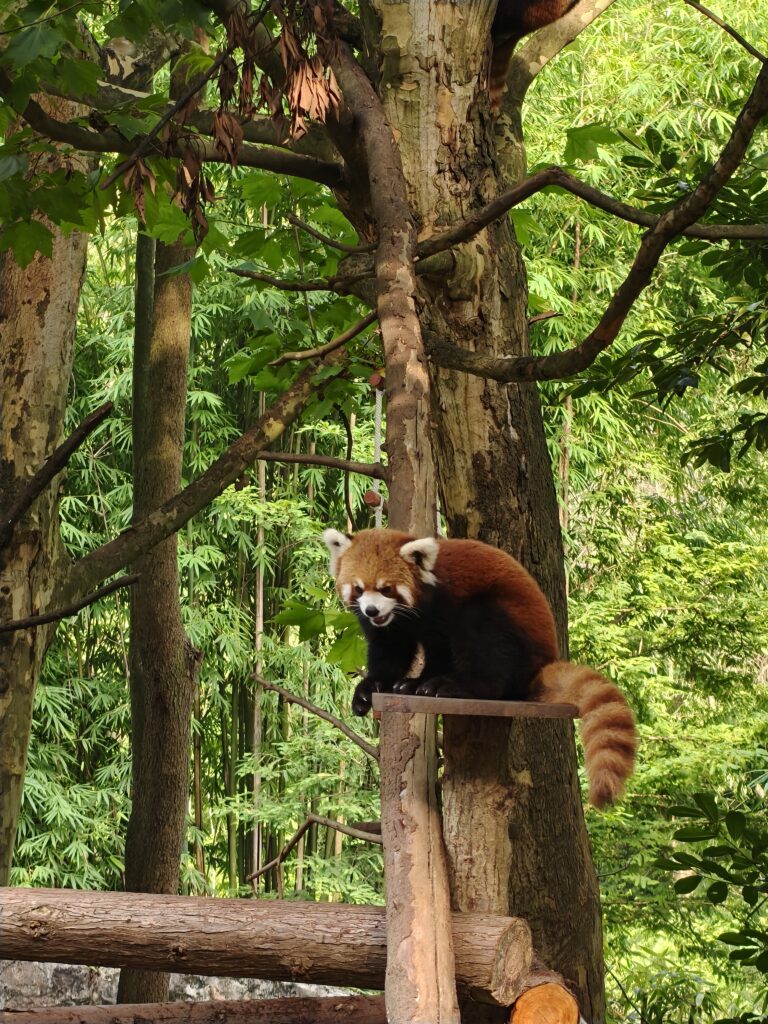
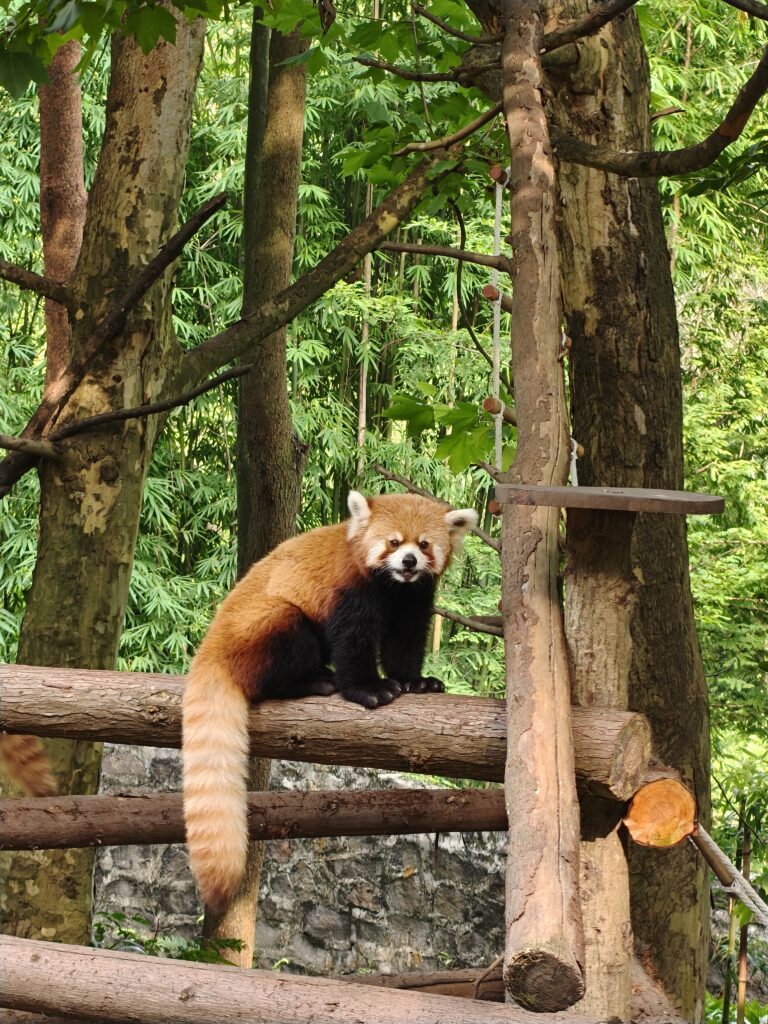
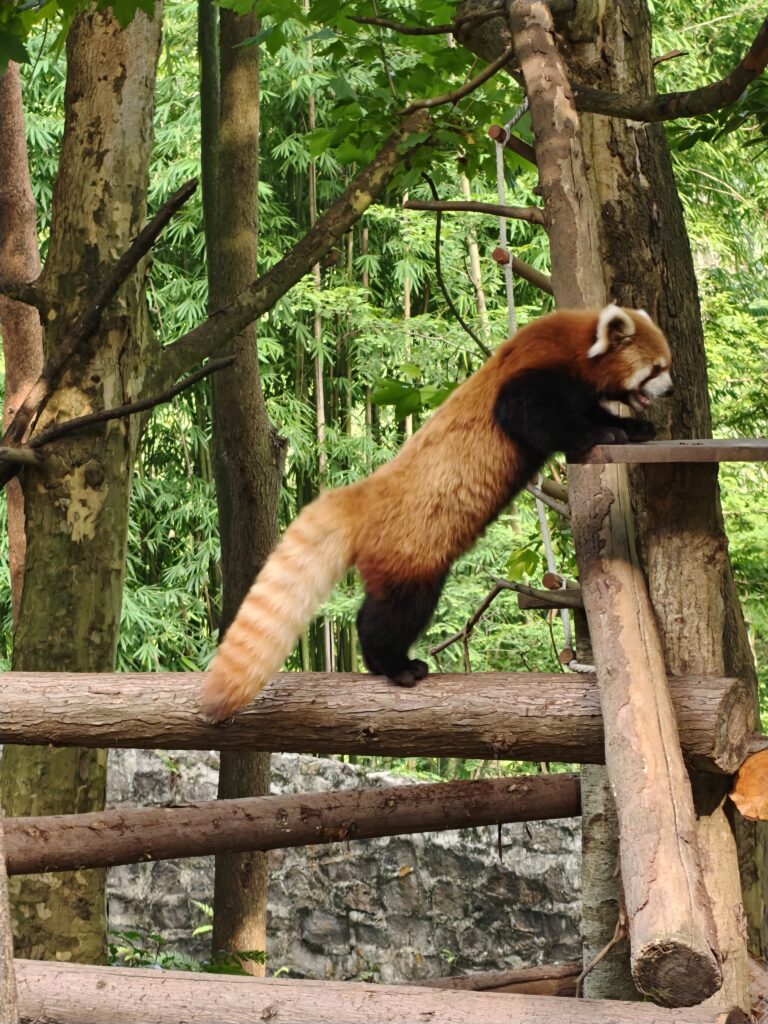
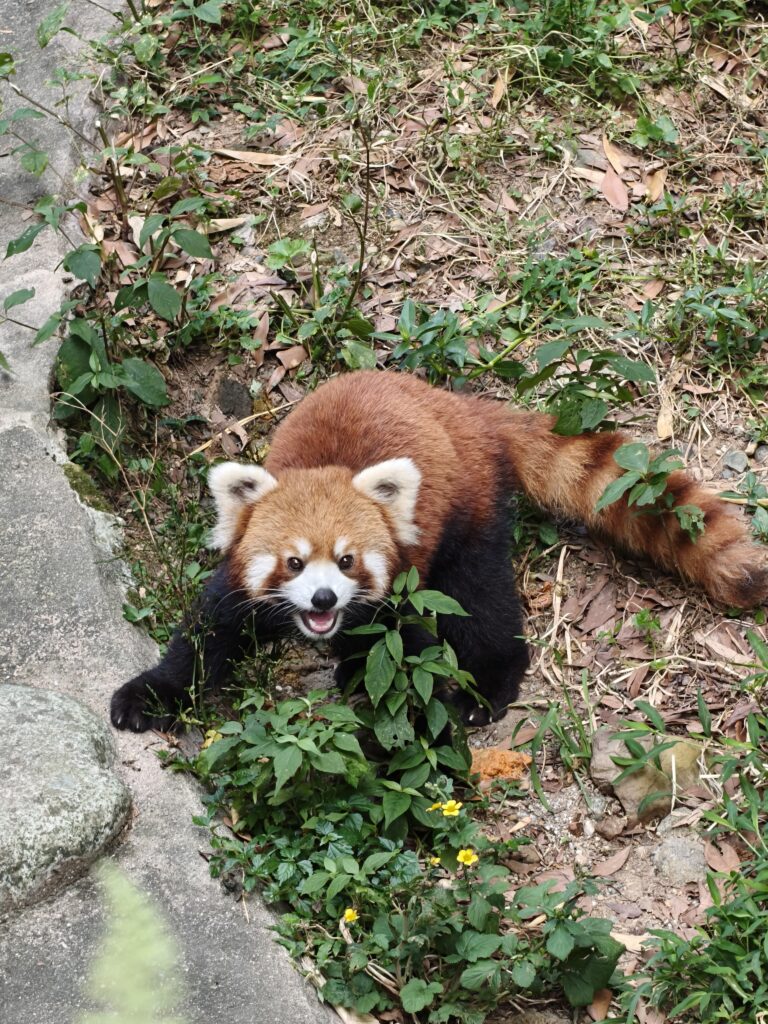
The next panda was lying down in the grass while he gnawed on his bamboo breakfast. Later on we saw a group of three pandas who sat or reclined on a wooden platform. We watched these for a while. Eventually, they headed back toward their inside area, but one of the pandas didn’t want his friend to go inside, so he grabbed his leg to keep him from going in. It was so fun to watch the pandas playing with each other and relaxing. There were quite a few people at this point, but it wasn’t unbearable, and we could still get some good views and videos of the pandas.
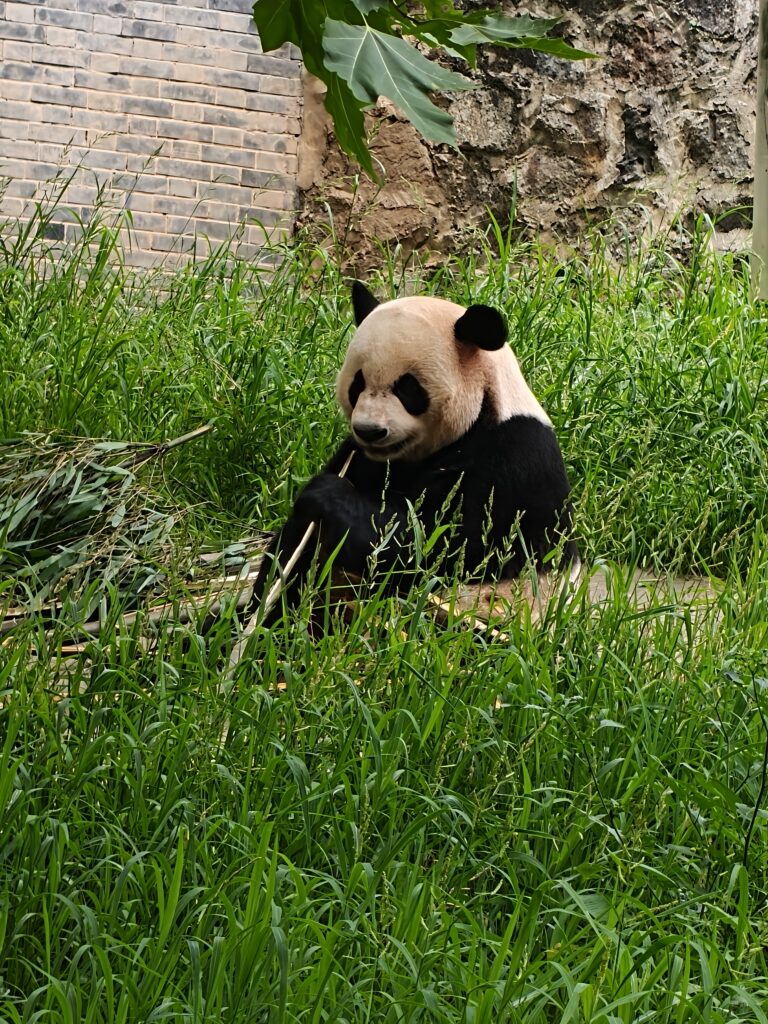
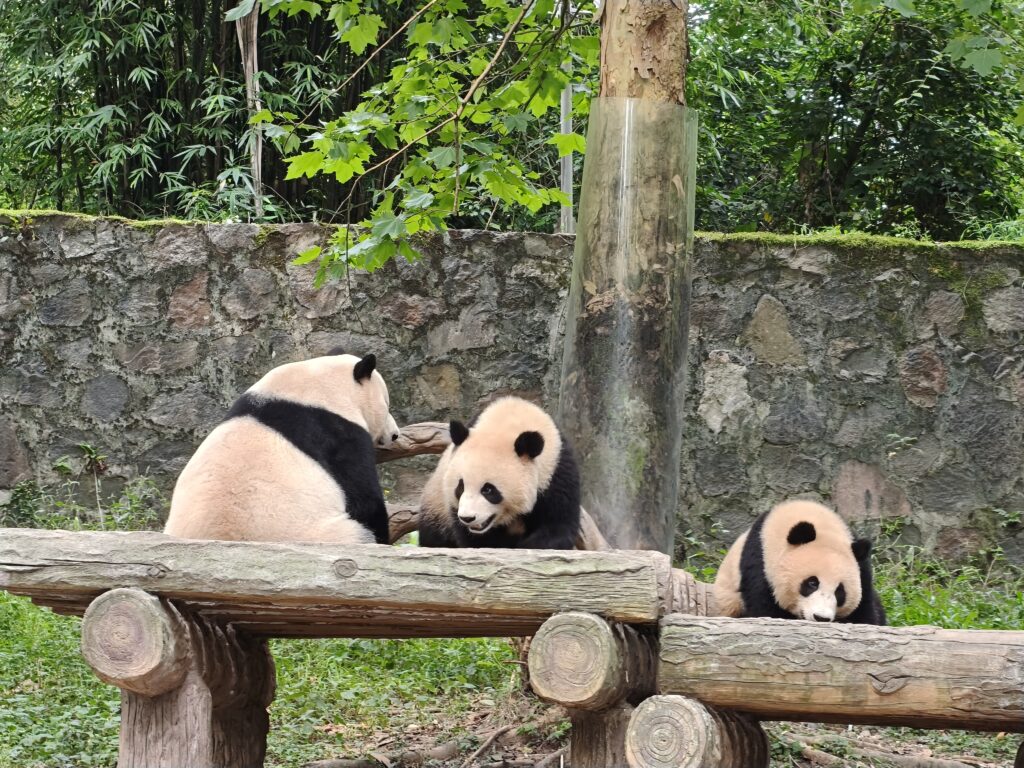
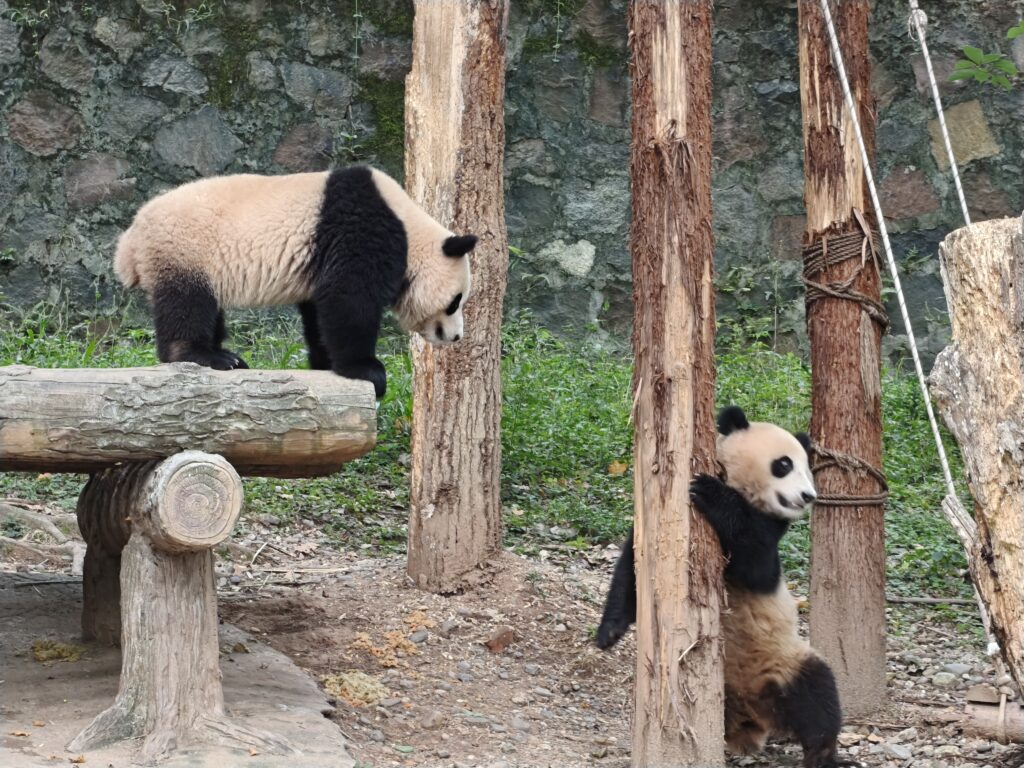
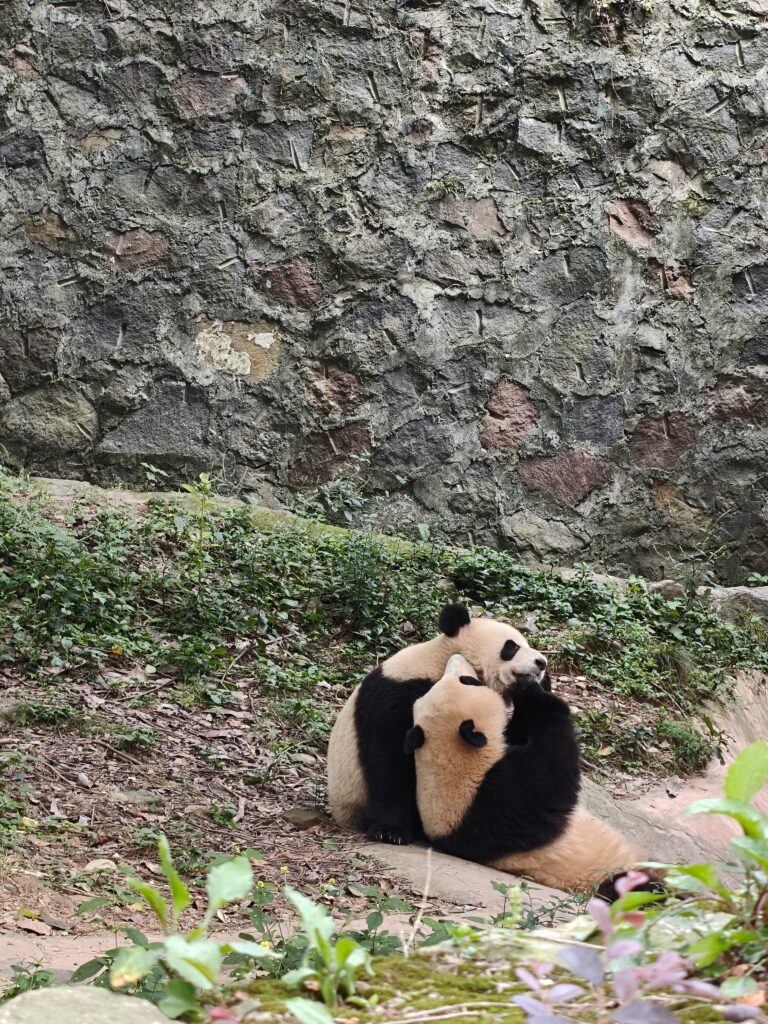
We watched as one panda heard someone at the gate to his inside area. The gate was closed, but he really wanted inside, and we heard him making some kind of bleating sound, talking to the people inside. Eventually, they opened the gate to let the panda in.
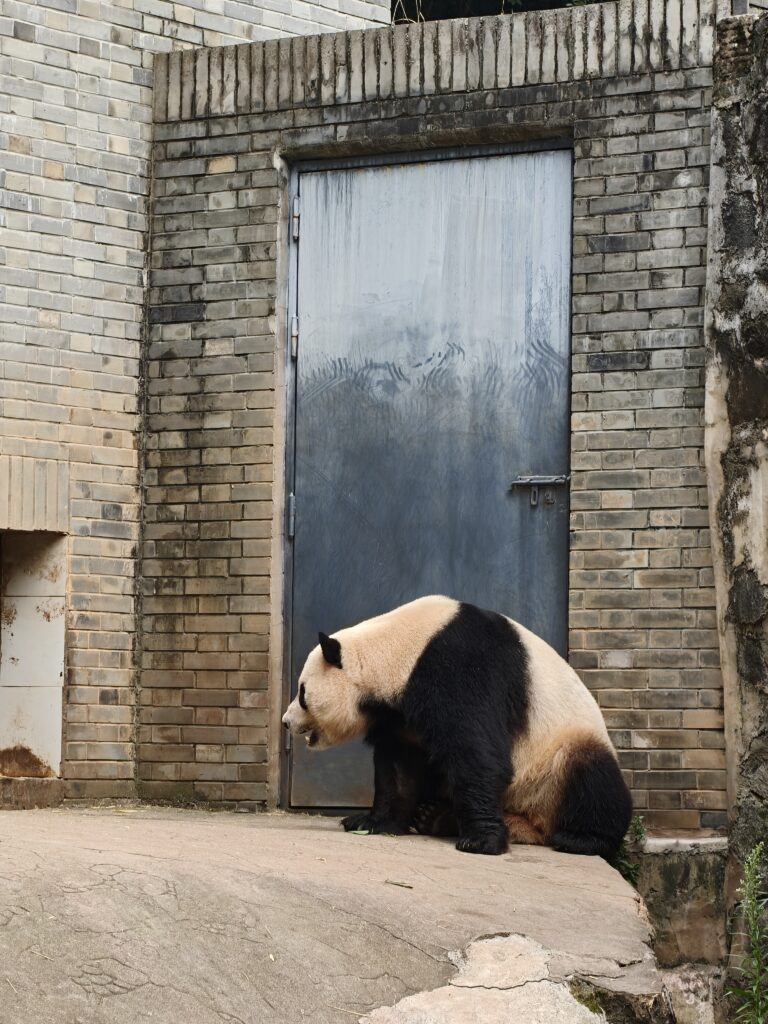
Towards the end of our time in the park, we saw a panda on top of his wooden structure, but he decided to get down. We watched in fascination as he maneuvered himself into a nearby tree and then lowered himself down, poking his head through the trunk of the tree as if posing for pictures for the watching crowd.
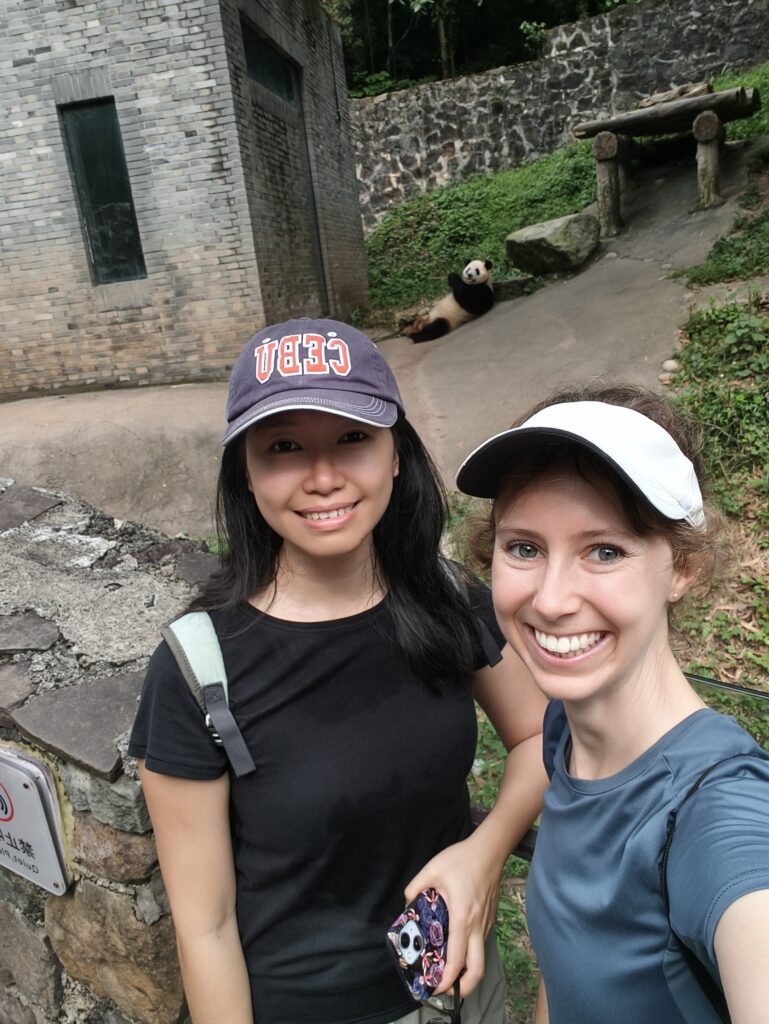
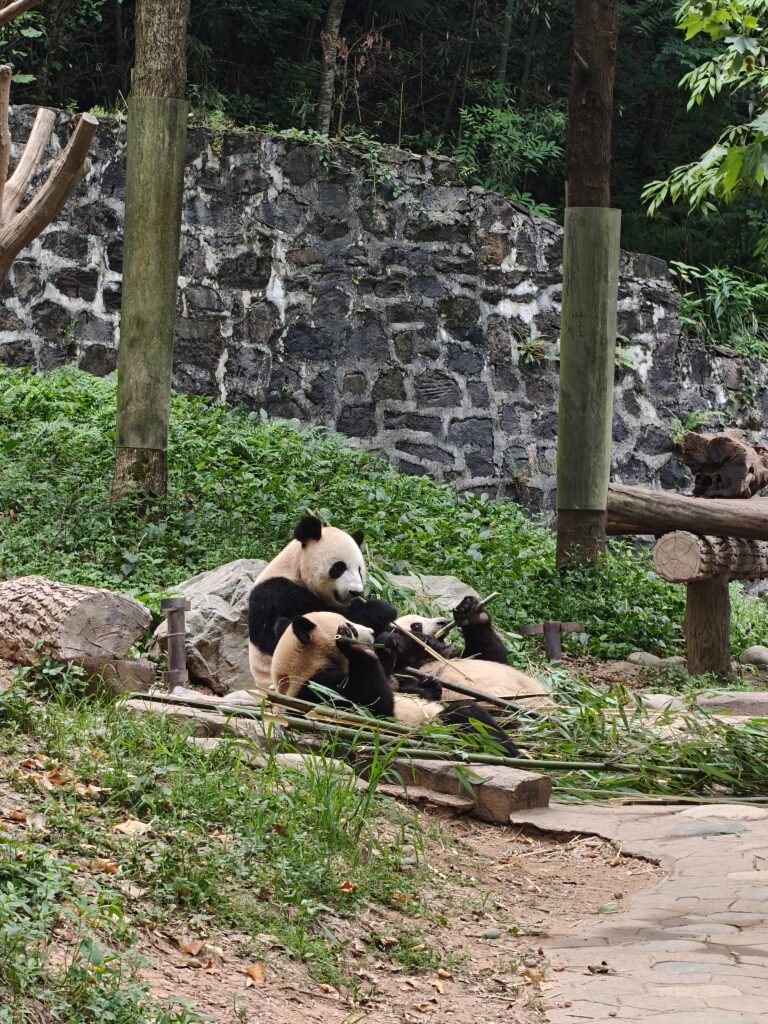
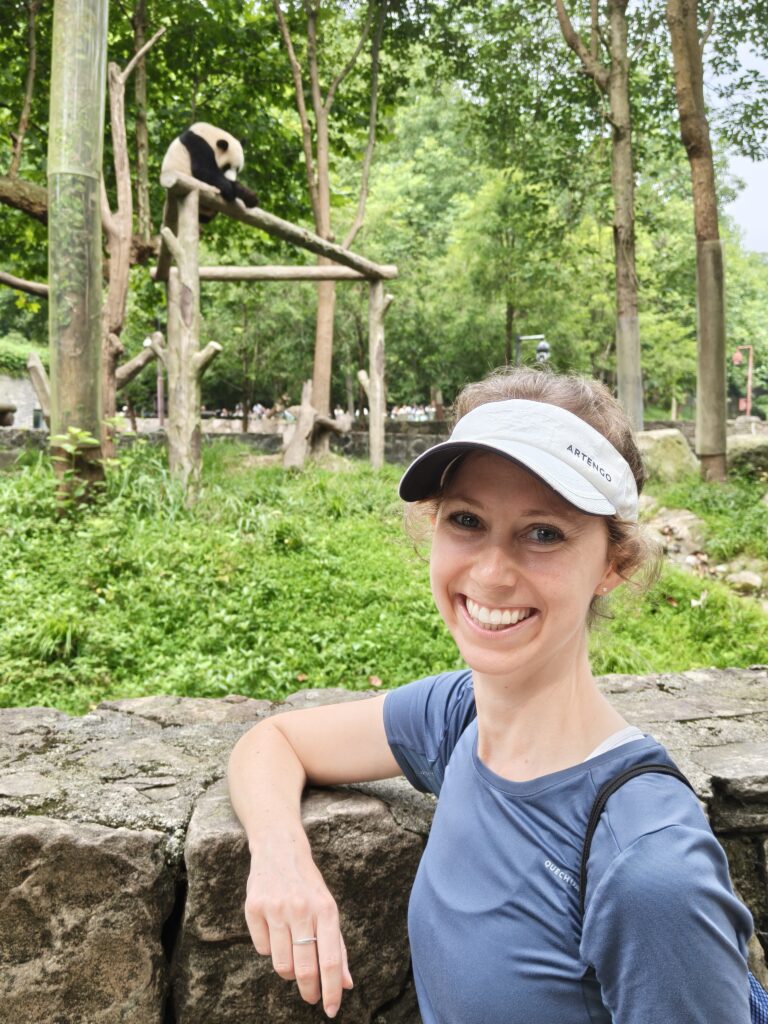
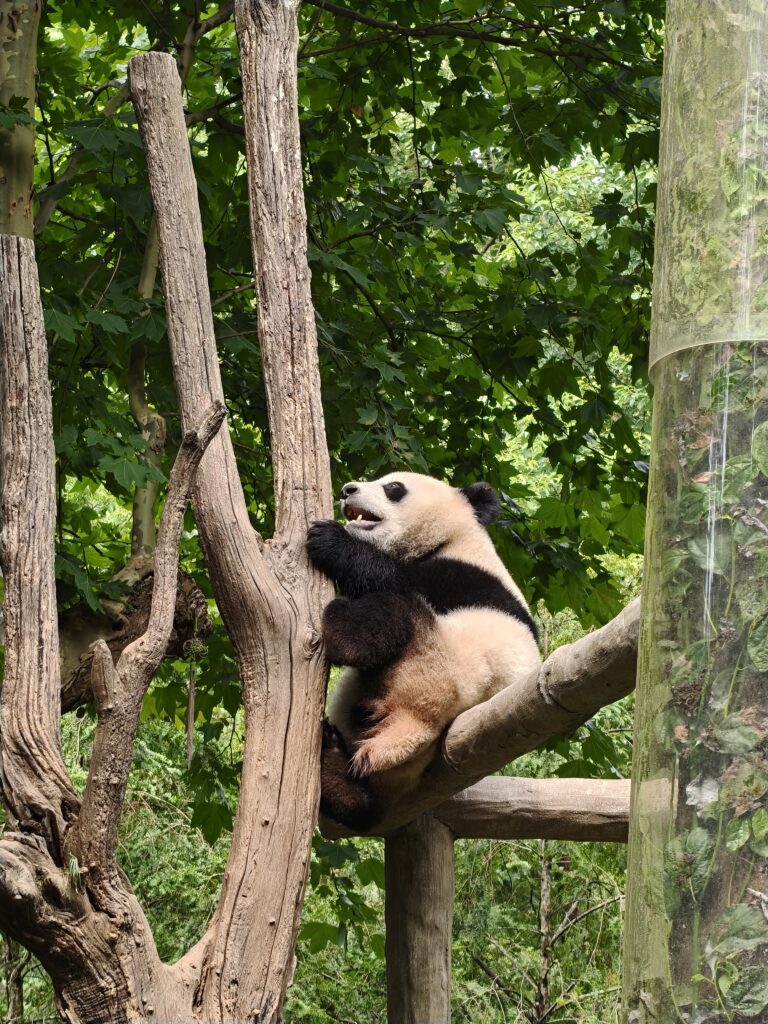
Since the traffic was bad near the mountain, and we really wanted to have time for Dujiangyan, Jaye and I decided to just go directly there. On the way, we passed through a little village. The traffic ahead was looking pretty bad, and I suggested that we stop and take bikes for the rest of the way. Since it was lunch time by now, we decided to eat lunch at a restaurant first. Jaye found a restaurant with good ratings and we headed over for some incredible fish! They also gave us a bean and radish local specialty for free.
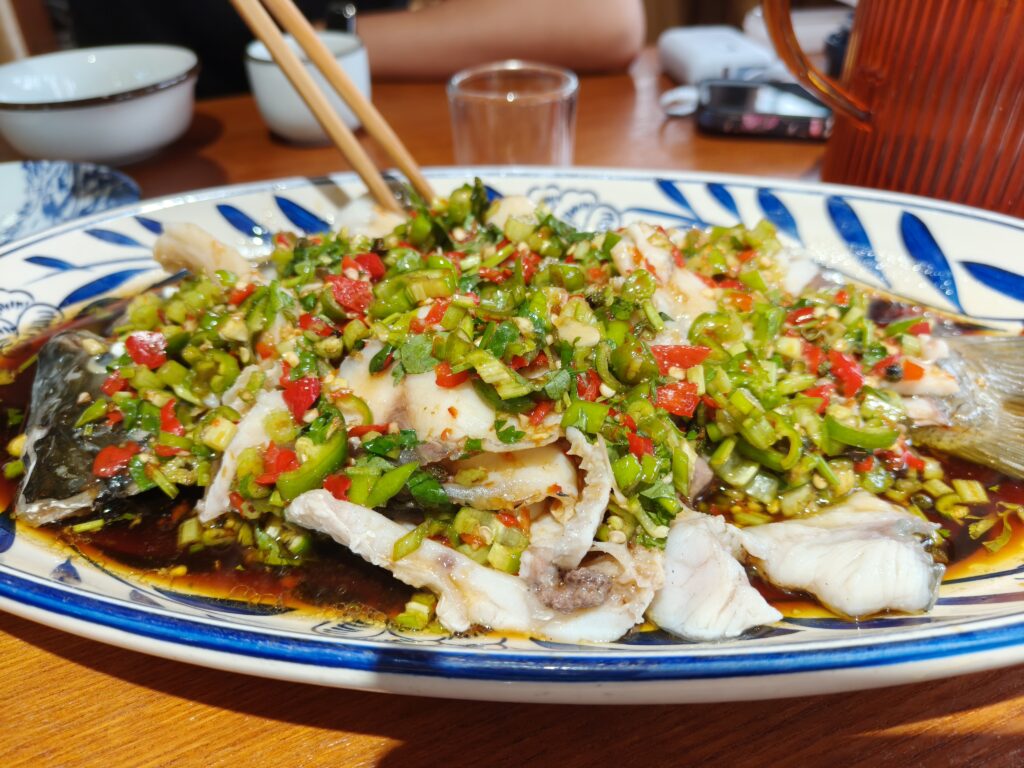
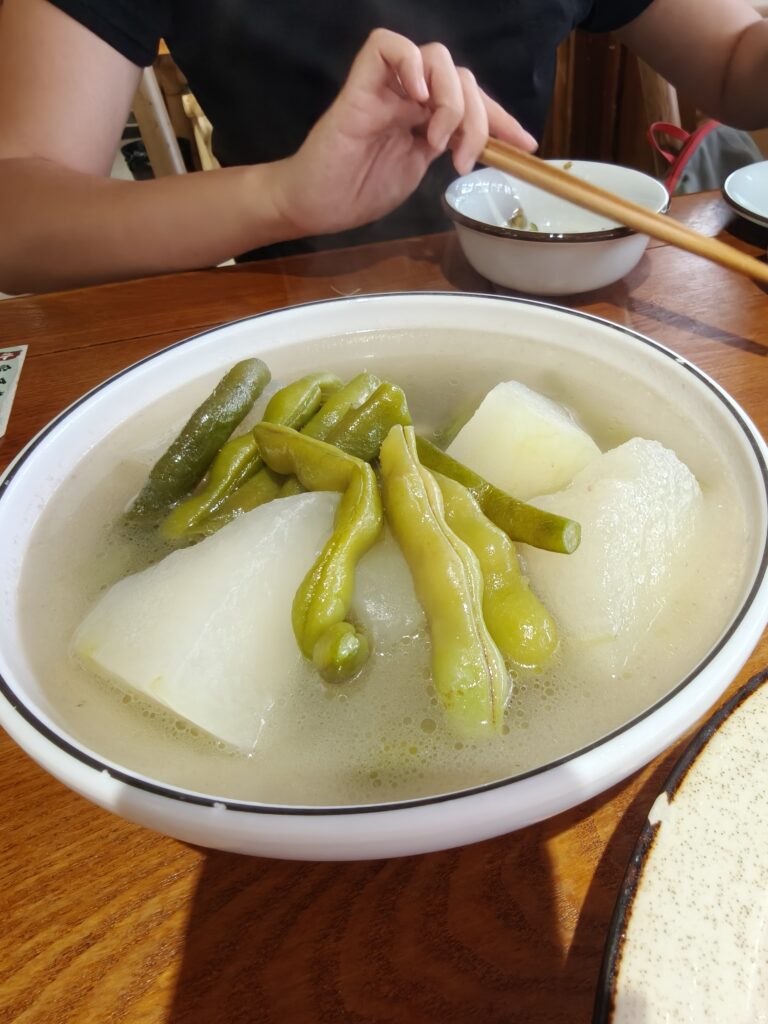
We ended up at Dujiangyan‘s side entrance (one of many). This side entrance was a temple that was on one side of the park. We wandered around that section for a while, trying to find the main points that Jaye wanted to see, but after lots of stairs and a wrong turn or two, we decided to just head toward the main area without trying to see everything.
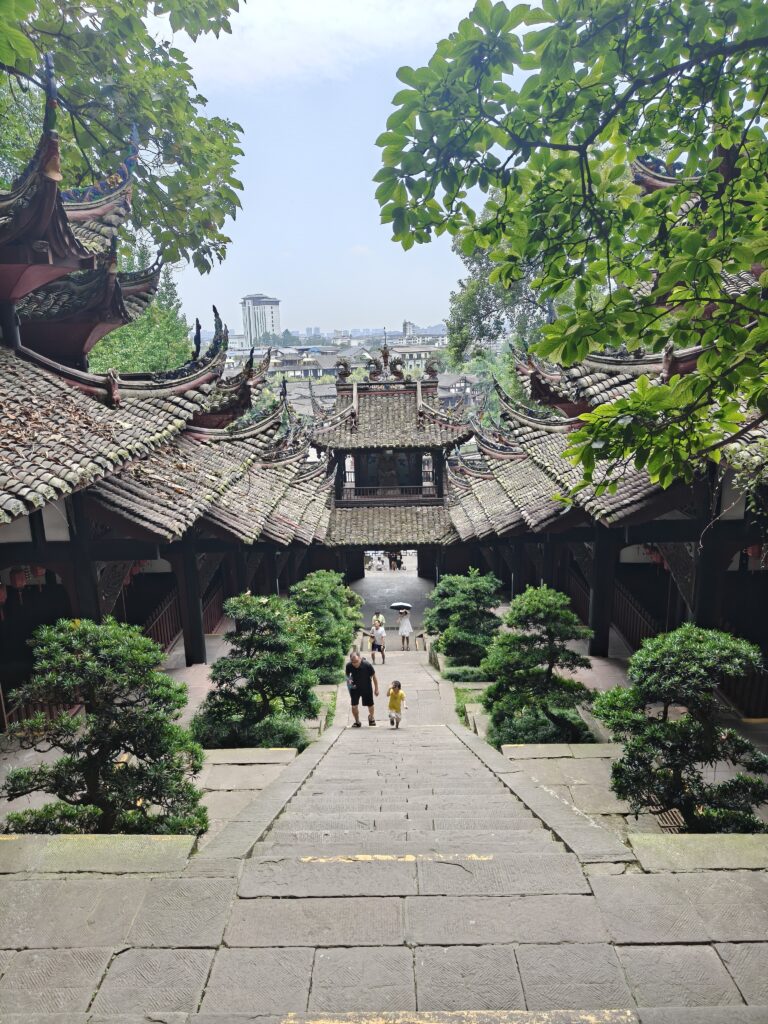
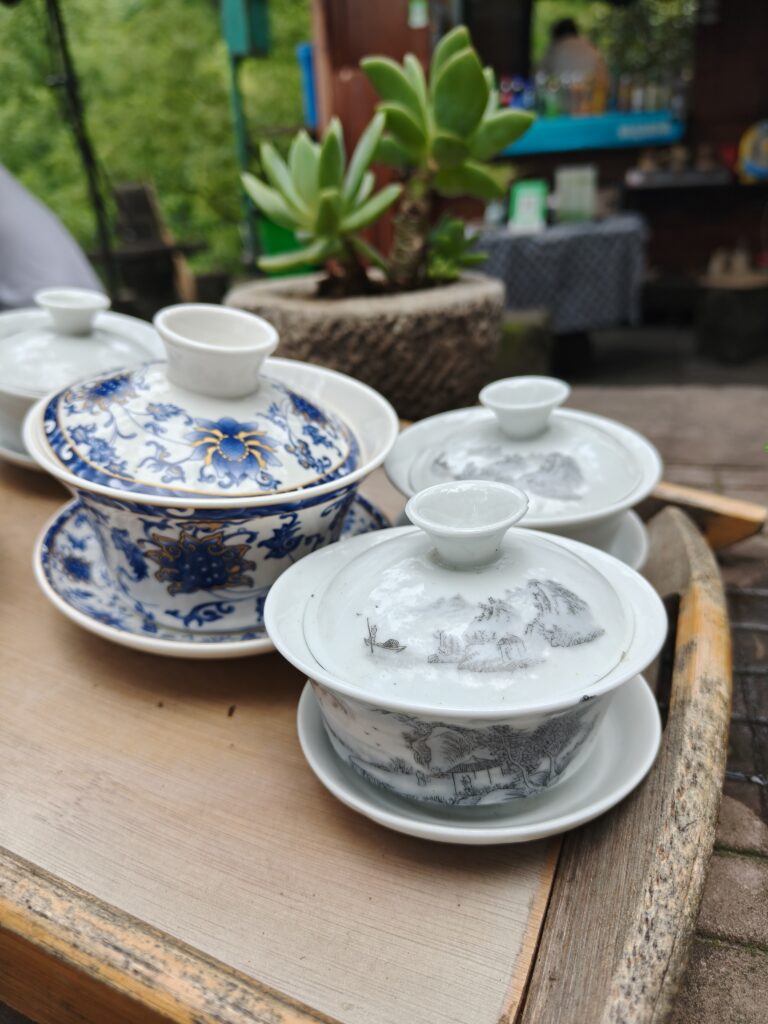
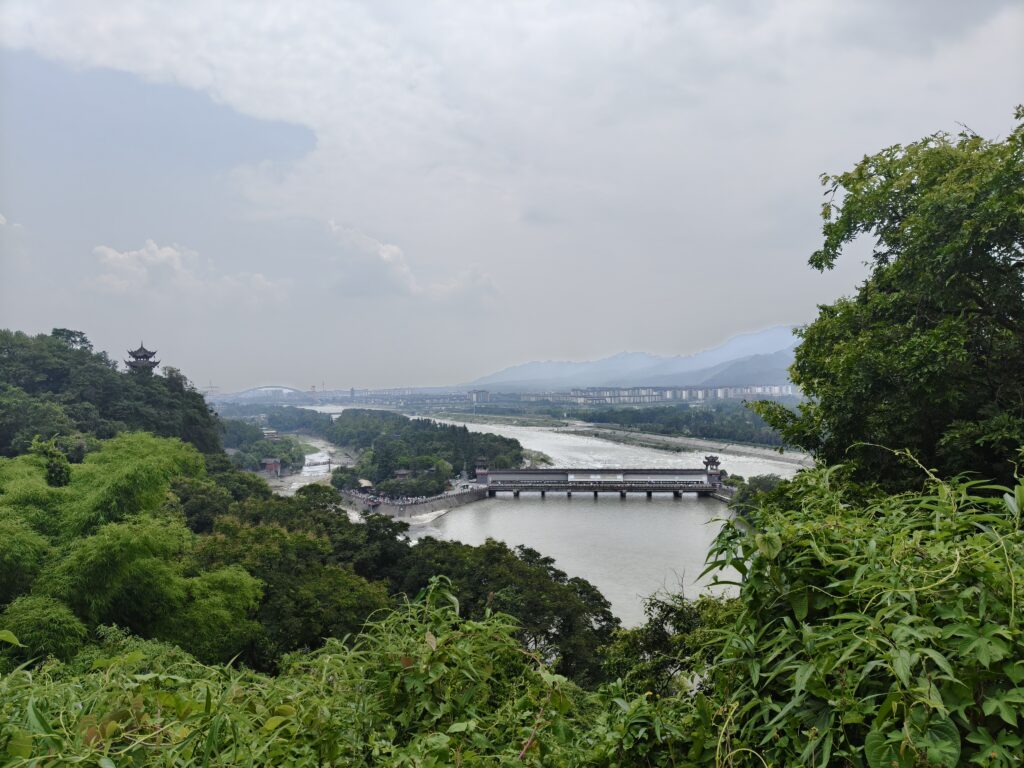
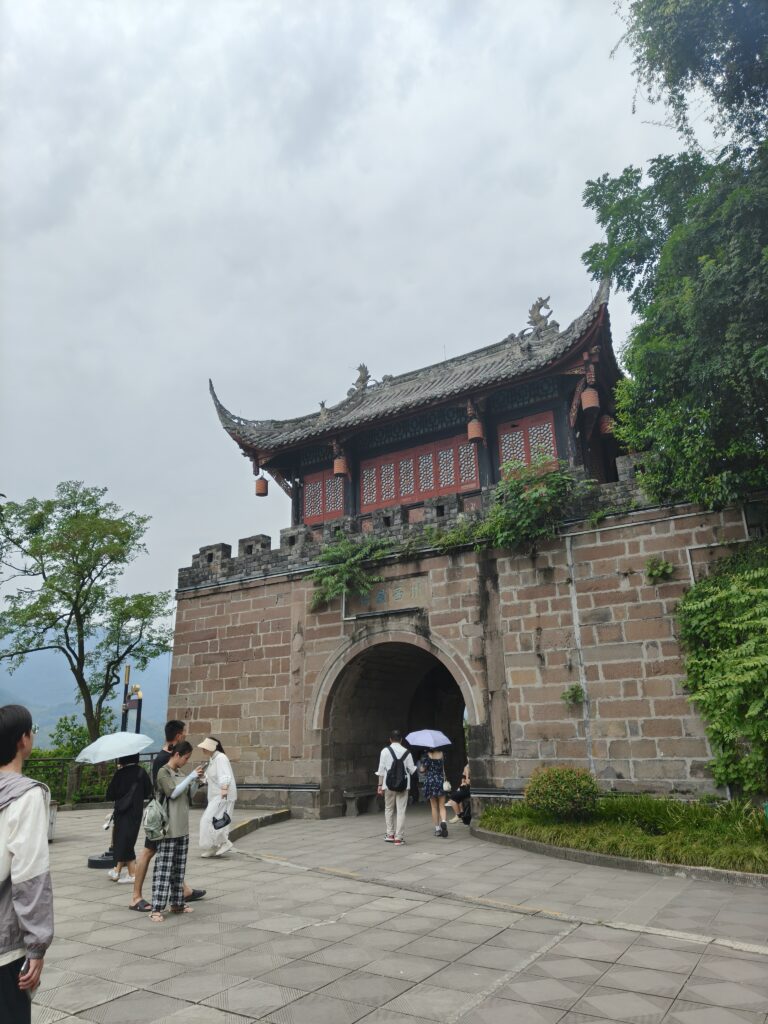
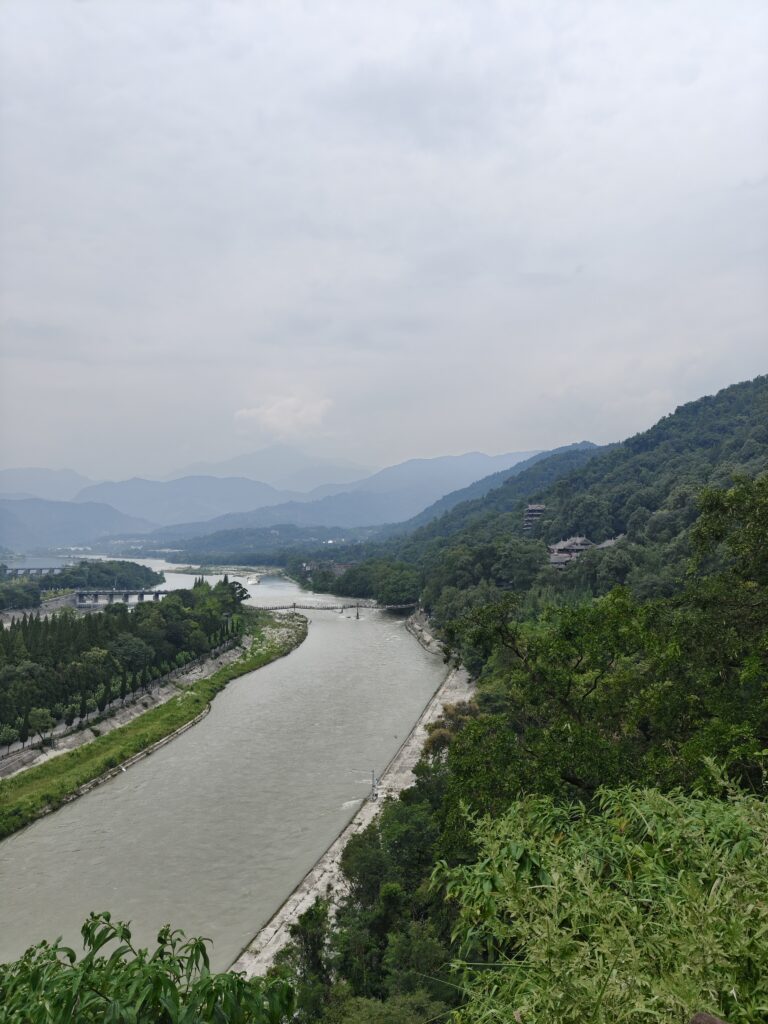
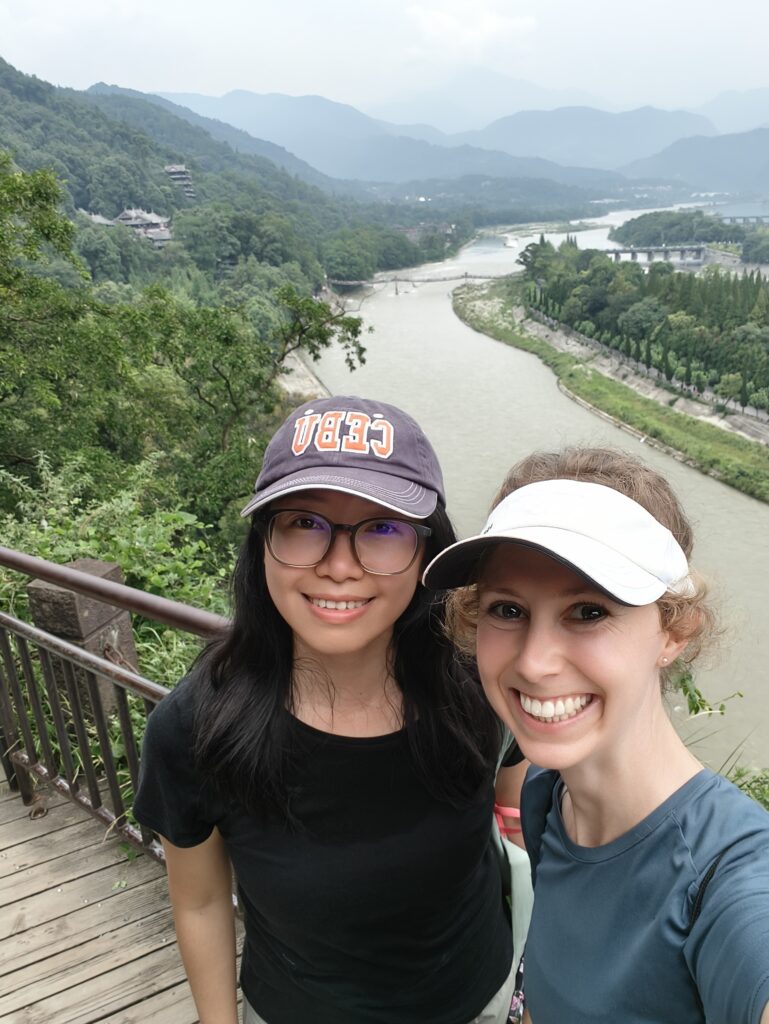
I first heard about Dujiangyan in my Chinese class that I had online. I asked my teacher to teach me about different places in China, so she copied texts from tourist books and had me read them and tried to explain the important places in Chinese. When she taught me about Dujiangyan, I remember coming away feeling like it was an important place for the city and it was an incredible feat of construction for the ancient people, but I was a bit unclear about all the details.
Jaye found a video that explained the place a bit more, and after watching that video, I had a much clearer understanding of the place. Basically, Chengdu was next to a river, and with the river, it was easy for the city to get completely flooded, but damming the river meant drought as the crops dried. So the ancient people built a side channel for the river to lead to Chengdu and divided the river into two sections: inside river and outside river (内江 and 外江). The inside river was deeper so that more water could go there during drier seasons, and the outside river was wider so that in seasons of heavy rain, more water would be able to go there. The point that divided these two sections was called 鱼嘴 (yuzui, literally mouth of the fish).
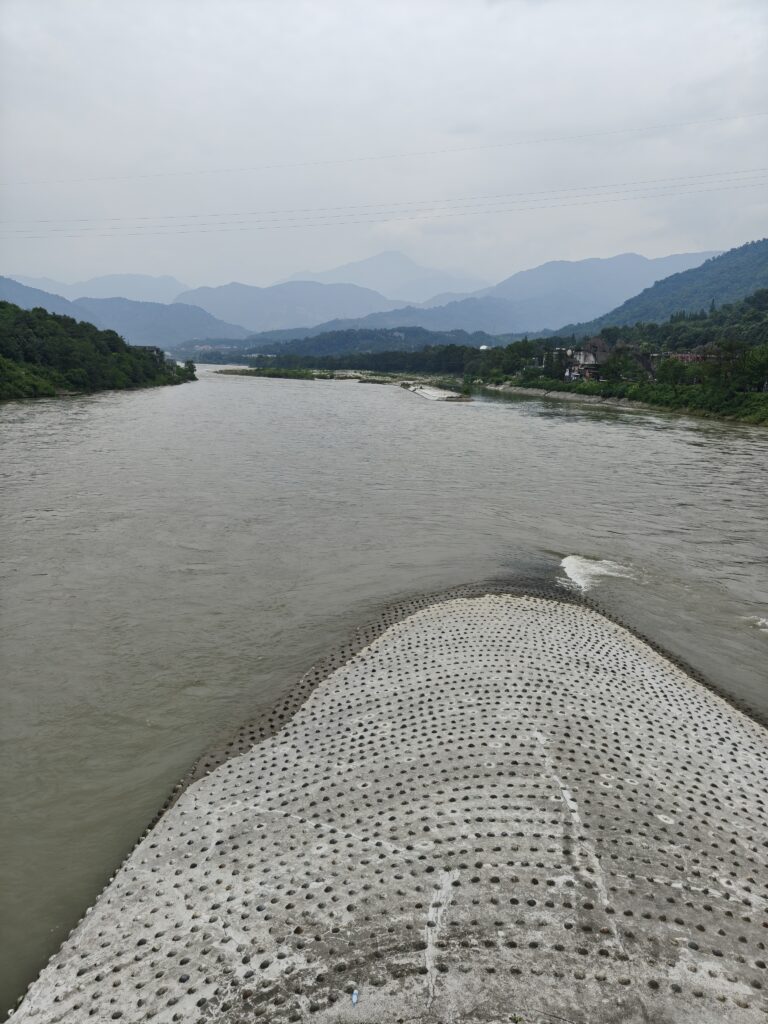
The ancient people also constructed several smaller side channels connecting the inside and outside rivers so that seasons of flooding or drought wouldn’t affect how much water went toward the city.
Another benefit of these different channels and points was that they were constructed in such a way as to direct more sand into the outside river, away from the city. This was done by the exact placement of the concrete structures and also took advantage of the water flow. In this way, the water going into the city would be much cleaner.
As I looked at Dujiangyan, I was a little confused about the value of the structures because I didn’t understand what they were for. I was also pretty tired at this point. But after watching the video, I could really see and understand the value of this area, and I had a much deeper appreciation for what the ancient people had accomplished. Li Bing, a local official of Sichuan province in 256 BC guided the people in this construction project (Liu, 2025). That was before Rome came to power in Europe, so quite a long time ago!
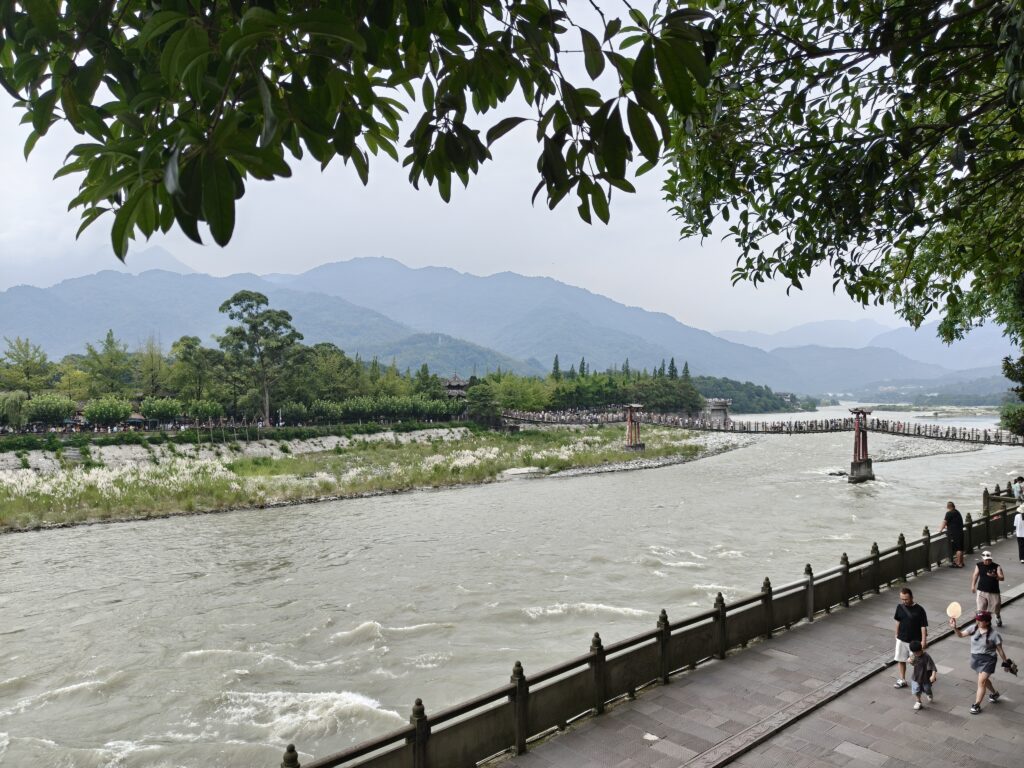
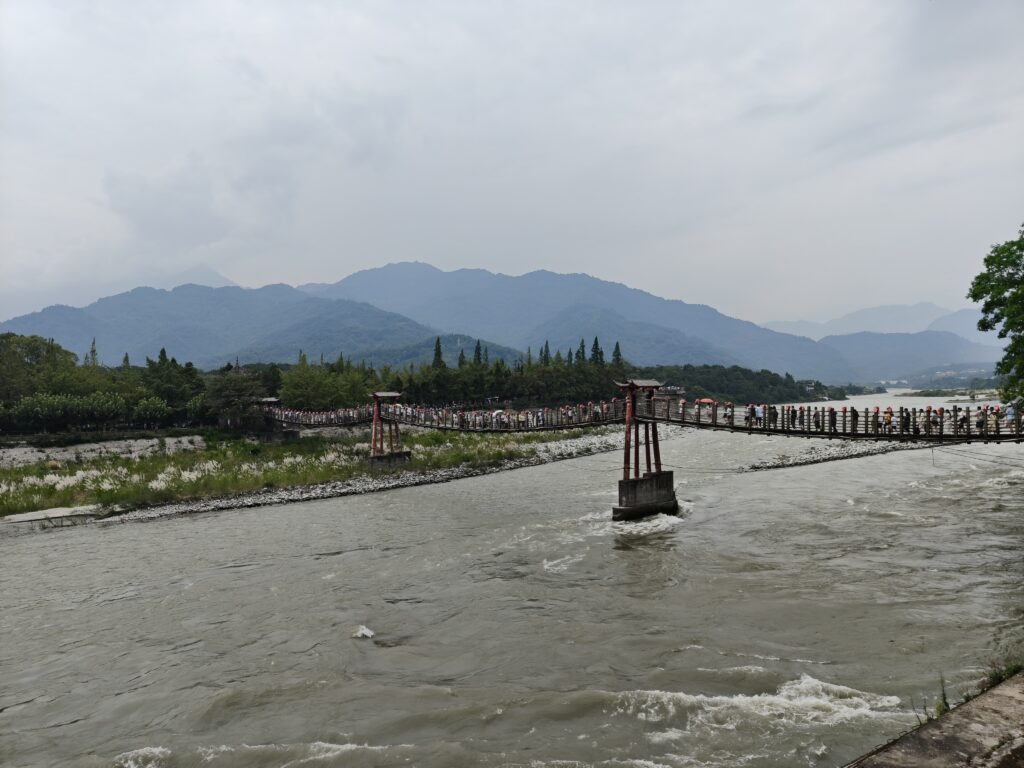
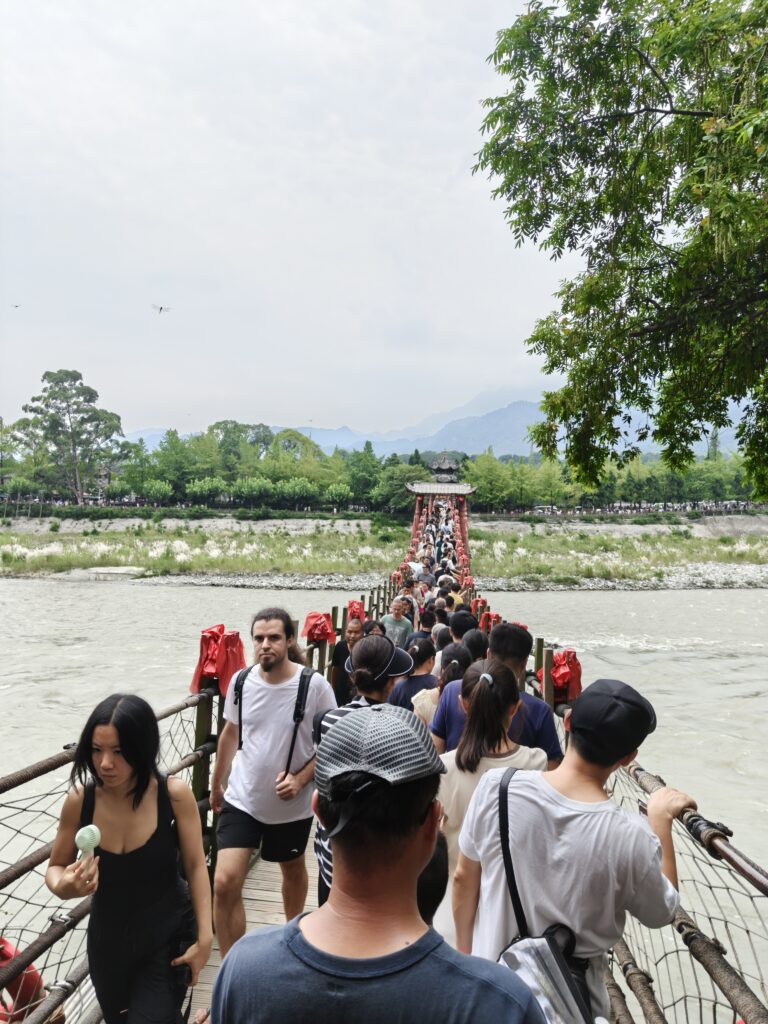
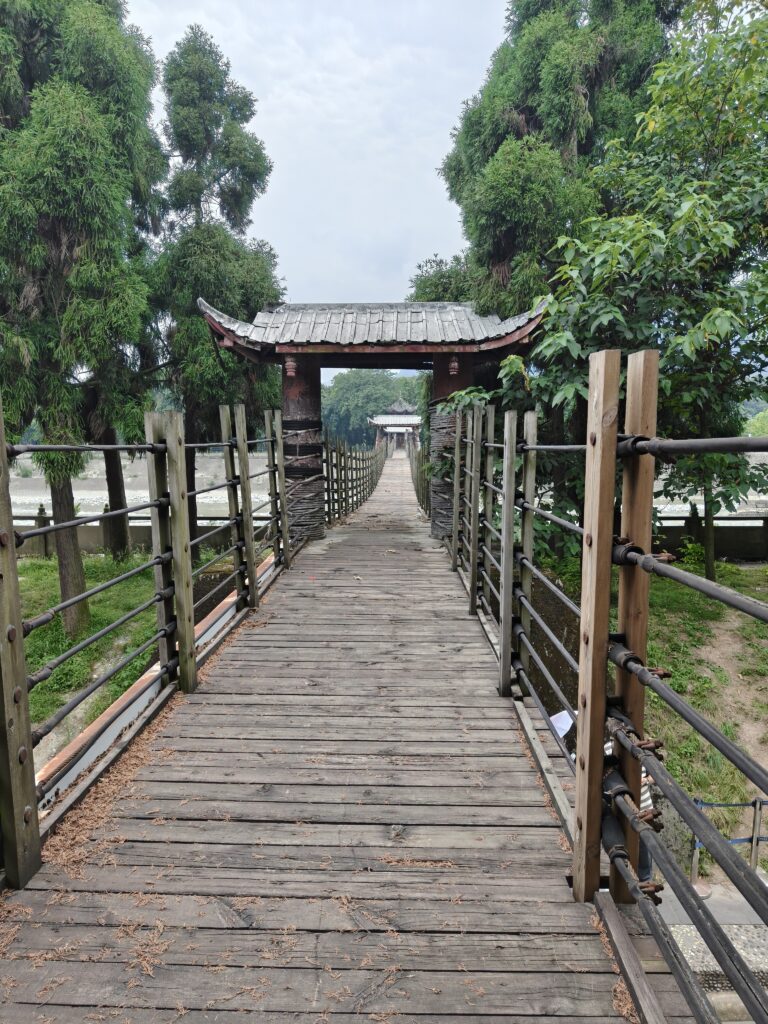
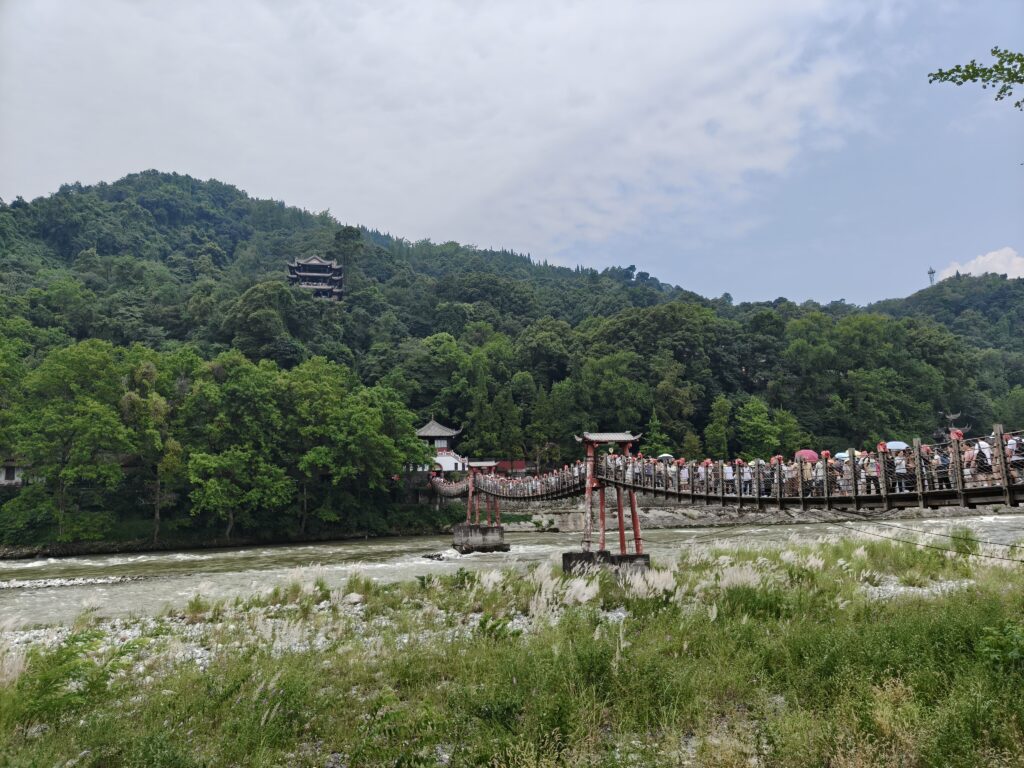
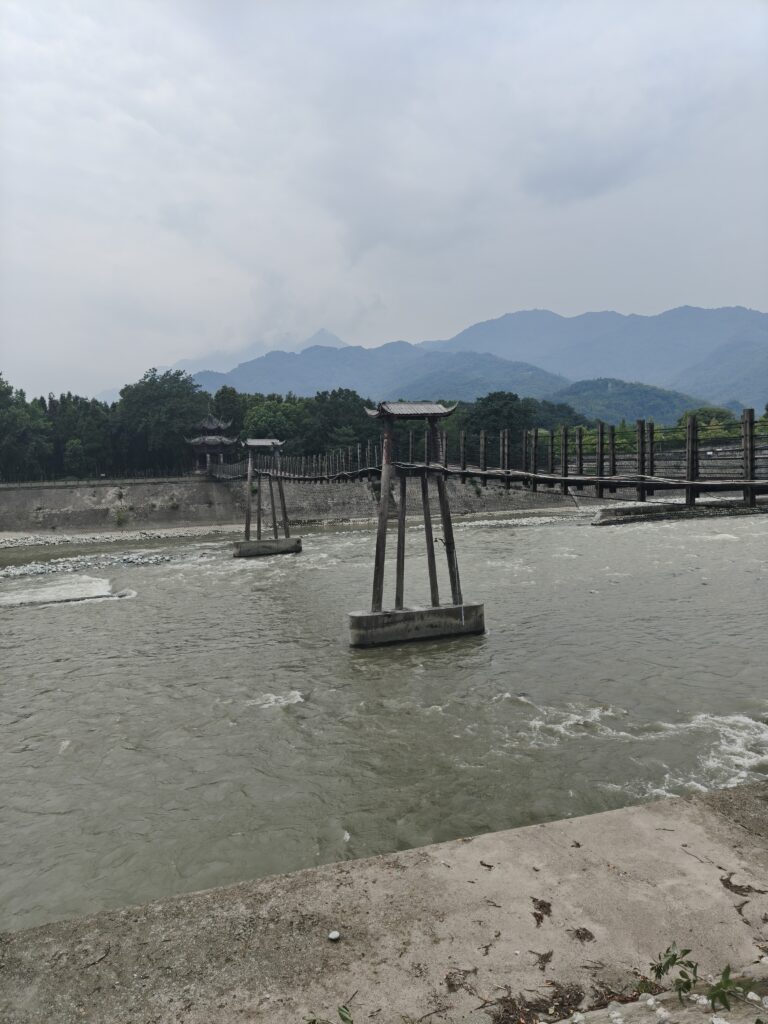
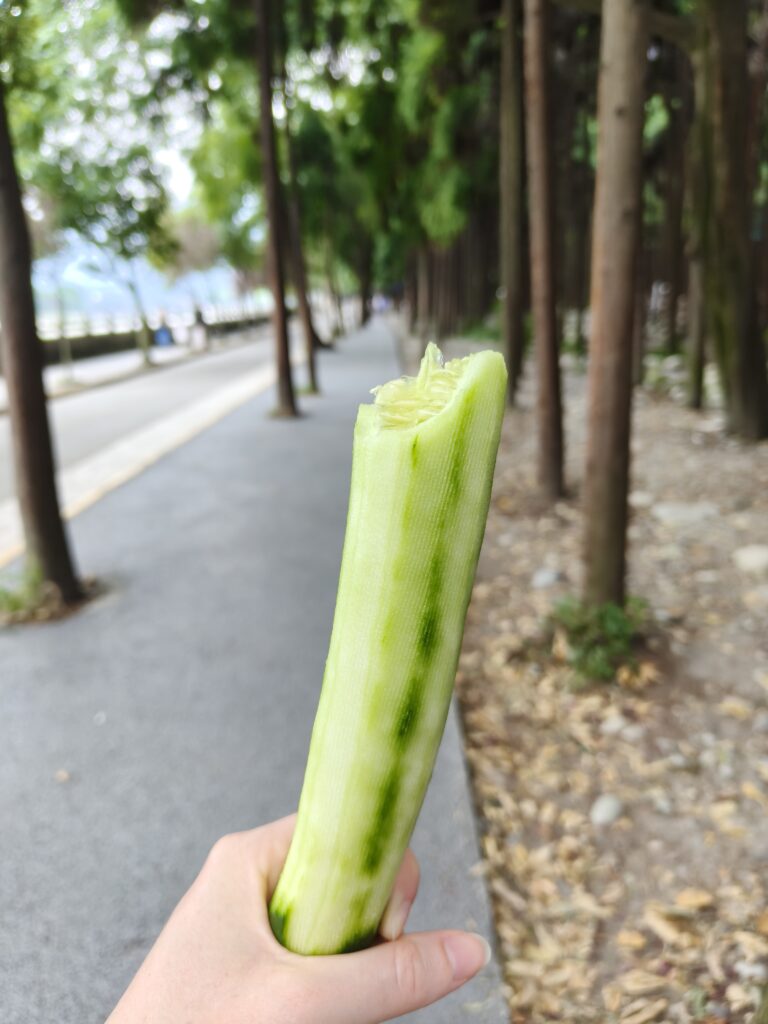
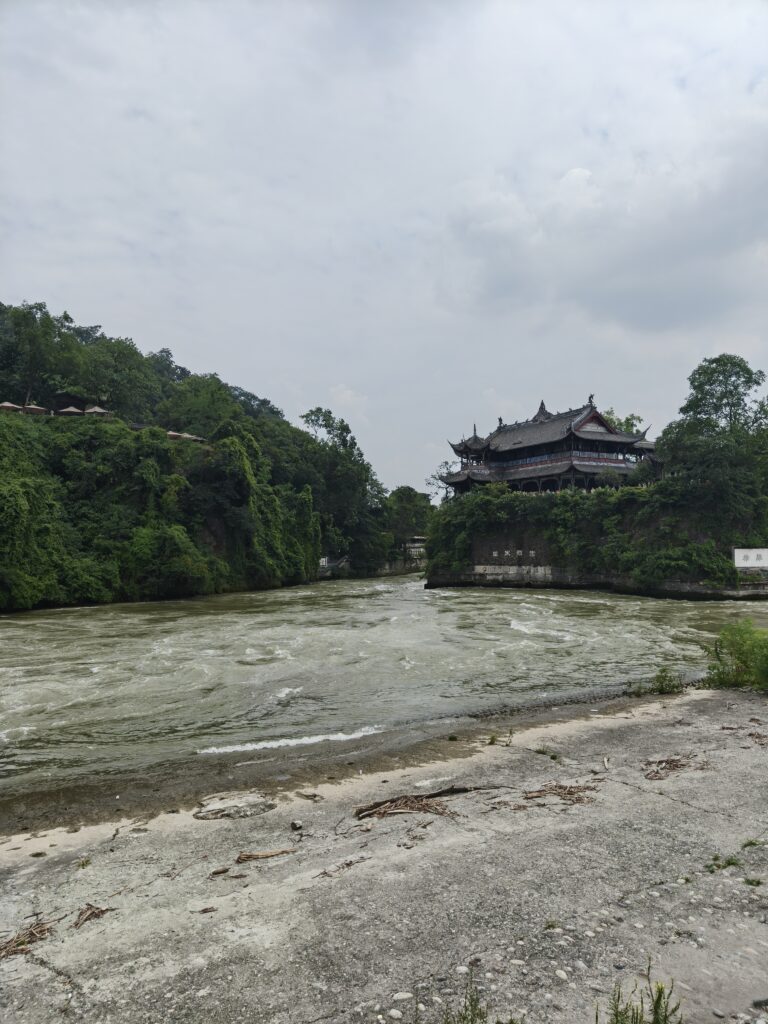
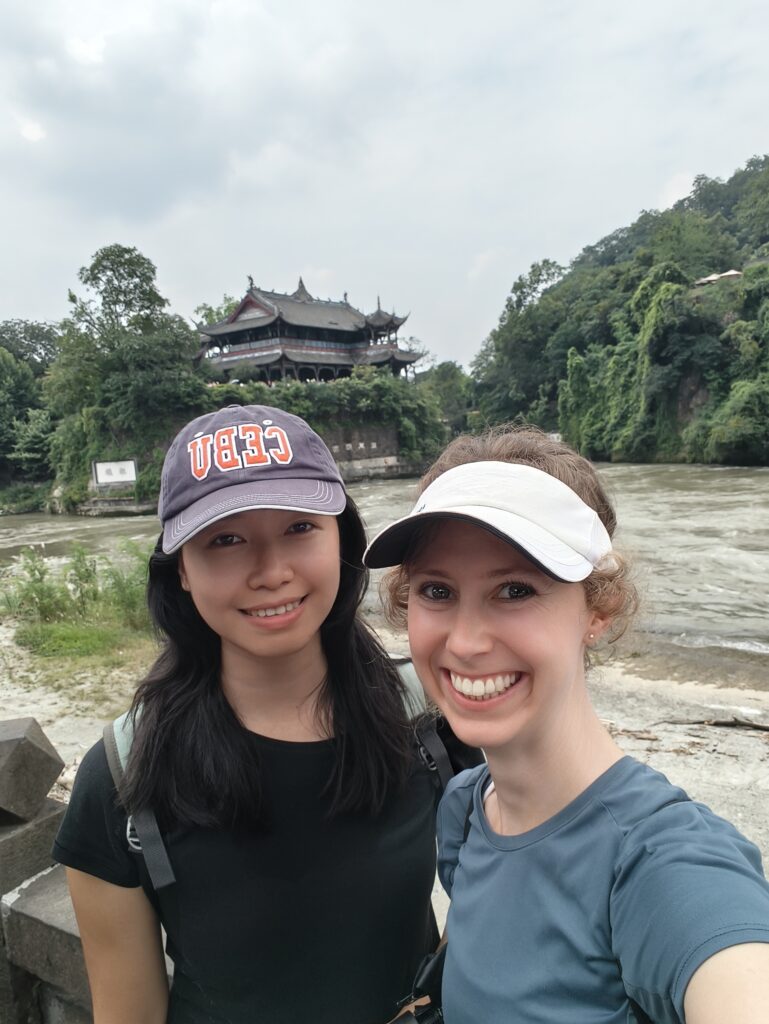
The trip back to Chengdu was a bit of a nightmare. The traffic was terrible, and since we didn’t know when we would finish, we hadn’t bought return tickets. By the time we did finish, all the trains were sold out. We tried to get a shared car (顺风车, shunfeng che), but the guy canceled it when we tried to change the location from the back to the front gate. We tried to get another car, and we finally got one, but when we got in, the guy said that we were going to wait a while so he could try to get some other people to join us (that’s the challenge of shared cars—cheaper but usually more complicated). We were exhausted and ready to be home, so we offered to pay him quite a bit more to leave immediately. He agreed, but pretty soon we realized that he thought the price we had named was on top of what we had already paid and we meant it was including what we had already paid. He refused to change his mind, so we got out, frustrated and now no longer at the entrance to the park.
Jaye was trying to get the refund for what we had already paid for that car, but the taxi driver refused to approve the cancellation. While she tried to deal with that, I ordered a new car. We decided to just get a private car back at this point. It was more expensive, and we had to pay a little extra because we weren’t at the departure point on time—still walking back to the entrance from where the first shared car had dropped us off. But it was still worth it to have our own car and to be on our way back to the city.
After talking to customer service, Jaye also finally managed to get the refund from our failed trip. I feel sorry for car drivers who have to work in that kind of cutthroat environment all the time, always trying to make more money and not being completely honest with customers so that they can try to get more people to come with them. I’m glad my job is much more stable and relaxed than that.
Back in Chengdu, Jaye and I met Shirley for some 冒菜 (mao cai) which is a spicy pot of broth filled with meat, vegetables, tofu, or whatever else you choose to put in it. Mao cai is similar to 麻辣烫 (malatang) except that malatang is individual, and mao cai is a shared pot for a group. The disadvantage is that Jaye and Shirley can both tolerate a higher spicy level than I can. But the food was delicious, and my mouth and my stomach survived!
After that, Shepard joined us and we went out for 豆花 (douhua), another local specialty that’s basically a tofu sweet soup. So many fun adventures, and by the time we were done, I was completely exhausted!
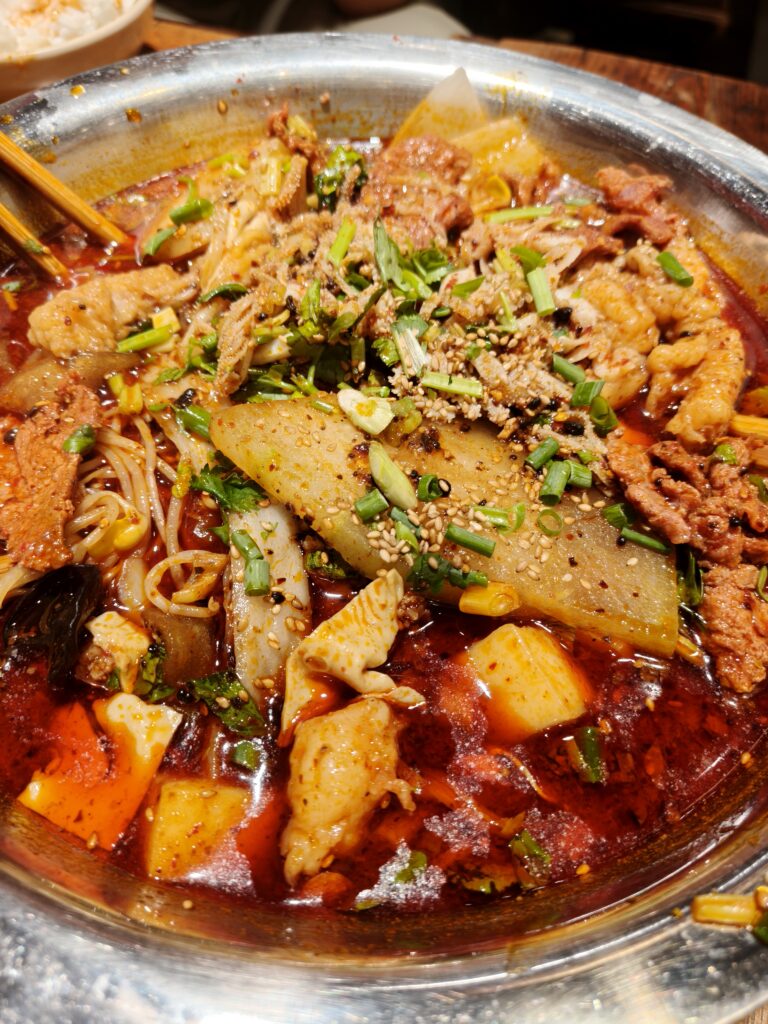
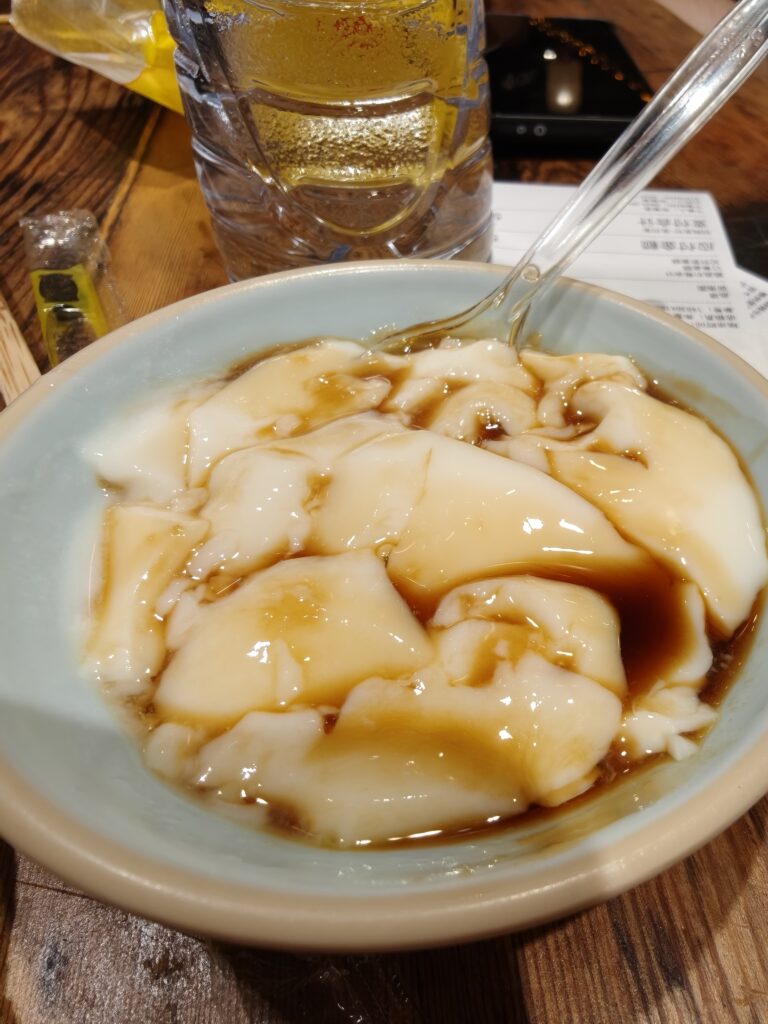
References
Liu, O. (2025). Dujiangyan Irrigation System. China Journey Guide. https://www.chinajourneyguide.com/dujiangyan-irrigation-system/
Video: 都江堰 by 扇子有画 on Xiaohongshu.

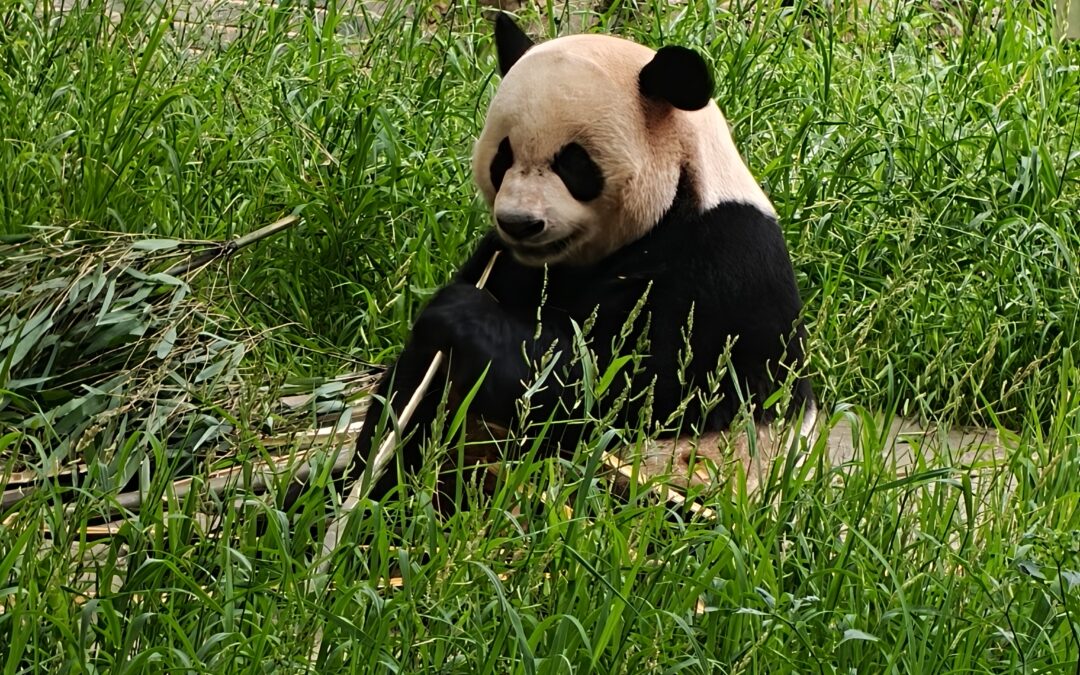
Always love your stories!
Thanks! Glad you enjoy them!